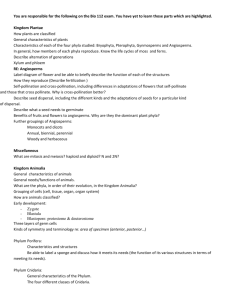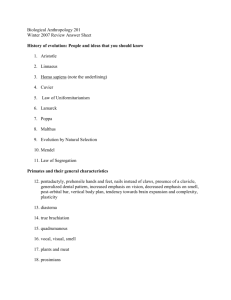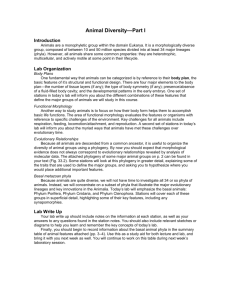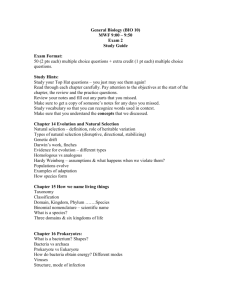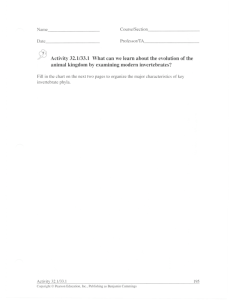Porifera
advertisement
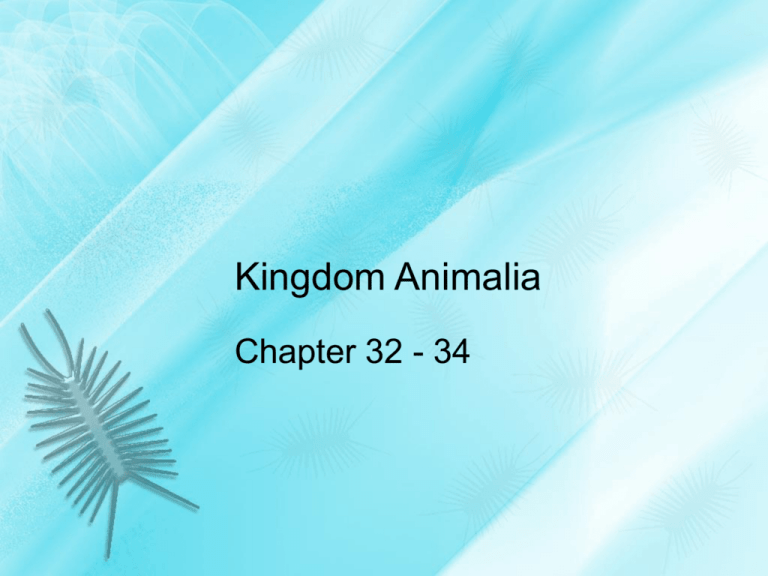
Kingdom Animalia Chapter 32 - 34 What you need to know! • The characteristics of animals. • The stages of animal development • How to sort the animal phyla based on symmetry, development of a body cavity, and the fate of the blastopore • The traits used to divide animals into groups • Examples and unique traits for each phylum discussed. • The evolution of systems for gas exchange, respiration, excretion, circulation, and nervous control • The 4 chordate characteristics • Traits which distinguish each of the following groups: Chondrichthyes, Osteichthyes, Amphibia, Reptilia, Birds, and Mammalia • Adaptations that allowed animals to move onto land. • How the three classes of mammals differ in their reproduction Phyla 1. 2. 3. 4. 5. 6. 7. 8. 9. Porifera Cnidaria Platyhelmithes Nematoda Mollusca Annelida Arthropoda Echinodermata Chordata Classification in Animalia Metazoa: most inclusive clad; all animal phyla; multicellular, heterotroph as opposed to protozoa (first life) Eumetazoa: true tissue animals; all phyla except porifera (sponges) Bilateria: symmetry; all phyla except cnidaria and porifera Deuterostomia: blastopore = anus; only echinodermata, chordata Porifera (“pore bearer”) Porifera • Simplest animal – no true specialized tissues • No gastrula during embryogenesis, no real germlayers • No muscle, nerve cells, digestive tract • Association of different specialized cell • Pores for water flow • choanocytes (collar cells) flagellated cells that create vortex to suck in water/food • amoebocysts (food digestion, food distribution) feeding through phagocytosis • skeleton cells make spicules made from calcium carbonate Porifera • • • • Sessile (attached to bottom) Spongocoel (central cavity) Osculum (large opening) Sexual reproduction: sequential hermaphroditism (produce both sperm and eggs at times in their lives) • Asexual reproduction: budding Cnidaria • hydra, jellies, sea anemones, corals • Gastrulation makes cnidarians diploblastic • endo/ectoderm • no mesoderm • Endoderm forms gastrovascular cavity (GVC): sac with a central digestive cavity – one opening • Polyps and medusa • Also called “Radiata”: Radial symmetry Cnidaria • Hydrostatic skeleton (fluid held under pressure) • Cnidocytes-cells used for defense and prey capture on tentacles • Special cnidocytes are Nematocysts: stinging capsule that when triggered release a harpoon-like stinger Nematocyst Platyhelminthes • flatworms, flukes, tapeworms • Bilateral, Triploblastic • GVC with only one opening • Acoelomates w/o body cavity: solid interior • Some cephalization: eyespot and nerve cluster anterior • Predators, scavengers, parasites with multiple hosts Tapeworm host cycle Nematoda • • • • • • • round, hook, heartworms Bilateral, triploblastic pseudocoelomate Complete digestive track Unsegmented No circulatory system Cuticle (tough exoskeleton) • Decomposition and nutrient cycling • freeliving or parasitic • Trichinella spiralis (tiny worm parasites) Mollusca • (mollus-soft) snails, slugs, squid, octopus, clams, oysters, chiton • Bilateral, true coelomates: • Digestive tract • Segmentation • Circulatory system w/ simple heart (open) • Internal or external shell calcium carbonate • Cephalopoda: developped eyes, cephalization Special molluscs • All have: foot (movement), visceral mass (internal organs); mantle (secretes shell); radula (mouth scraping organ) • Ciliated trochophore larvae • Classes: • Gastropoda: snails (stomach footed) • Bivalves: mussels (two-shelled) • Cephalopoda: octopusses (head footed) Annelida • segmented worms earthworms, leeches, marine worms • Bilateral, coelomate • Body segmentation • Closed circulatory system! • Metanephridia: excretory tubes • “Brainlike” cerebral ganglia • Hermaphrodites, but crossfertilize QuickTime™ and a Cinepak decompressor are needed to see this picture. Arthropoda • trilobites (extinct); crustaceans (crabs, lobsters, shrimps); spiders, scorpions, ticks (arachnids); insects (entomology) • Bilateral, coelomates • segmentation • most successful of all phyla • Extensive nervous system, muscles • open circulatory system with hemolymph • digestive tract Special features - arthropoda • hard exoskeleton (cuticle) made from chitin (fungi!, polysaccharide with some N) • Growth through molting • Metamorphosis: juvenile looks very different than adult • jointed appendages • Ventral ladder shaped nerve chord Metamorphosis Insect characteristics: • Outnumber all other forms of life combined • Malpighian tubules: outpocketings of the digestive tract (excretion) • Tracheal system: branched tubes that infiltrate the body (gas exchange) • Complete metamorphosis: larva, pupa, adult QuickTime™ and a Cinepak decompressor are needed to see this picture. Echinodermata • sea stars, sea urchins, sand dollars, sea lilies, sea cucumbers, sea daisies • Secondary radial symmetry (fake) due to bilateral larvae • Only deuterostomes other than chordates • Spiny skin; sessile or slow moving Echinoderm facts • Water vascular system by hydraulic canals (tube feet) • Simple Endoskeleton • Some segmentation (disk, feet…) • Short digestive tract • Some nervous system Vertebrate Evolution Clip and Diversity Phylum chordata Subphyla in Chordata Subphylum: invertebrate chordate • Urochordata and chephalochrodata: invertebrate chordates Subphylum: vertebrata Class: 1. Agnatha –jawless fishes 2. Chondrichtys-cartilage fishes 3. Osteichtys 4. Amphibia 5. Reptilia 6. Aves 7. Mammalia Invertebrate Chordates • Urochordata (tunicates; sea squirt); mostly sessile & marine and Cephalochordata (lancelets); marine, sand dwellers • Importance: vertebrates closest relatives; in the fossil record, appear 50 million years before first vertebrate • Intestinal tract, no circulatory system, not vertebral column, no gills Subphylum: Vertebrata; Class Agnatha • jawless fish lampreys, hagfish • Most primitive, living vertebrates • Cephalization in cranium • closed circulatory system • Lack paired appendages; cartilaginous skeleton; notochord throughout life; rasping mouth, no jaw • Predators preying on fishes Class: Cartilaginous Fishes • sharks, skates, rays • Cartilaginous fishes; well developed jaws and paired fins; continual water flow over gills (gas exchange); lateral line system (water pressure changes) • Closed circulatory system, gills • Life cycles: • Oviparous- eggs hatch outside mother’s body, frogs, fishes • Ovoviviparous- retain fertilized eggs; nourished by egg yolk; young born live reptiles, birds • Viviparous- young develop within uterus; nourished by placenta, mammals Class: Bony fishes • all other fishes • vertebral column • calcified bone most numerous • vertebrate Class: Amphibia • • • • salamanders, frogs, newts, toads 1st tetrapods on land Frogs, toads, salamanders, caecilians Metamorphosis; lack shelled egg; moist skin for gas exchange • No amniotic egg Class: Reptilia • • • • • Lizards, snakes, turtles, and crocodilians Amniote (shelled) egg Scales with protein keratin (waterproof); Lungs 3 chambered heart; exothermic (dinosaurs endothermic?) Superclass Gnathostomata, V • • • • • Class: Aves: Birds Endothermic Amniotic eggs 4 chambered heart Flight adaptations: wings (hollow-boned); feathers (keratin); toothless; one ovary • Evolved from reptiles (amniote egg and leg scales) • Archaeopteryx (stemmed from an ancestor that gave rise to birds) Class: Mammalia • Mammary glands; hair (keratin); endothermic; 4chambered heart; large brains; teeth differentiation to accommodate herbivore, carnivore • Evolved from reptilian before birds • Monotremes (egg-laying): platypus; echidna • Marsupials (pouch): opossums, kangaroos, koalas • Eutherian (placenta): all other mammals-placental mammals Order: Primates • Characteristics: hands & feet for grasping; large brains, short jaws, flat face; parental care and complex social behaviors • Suborder: Anthropoidea •monkeys, apes, humans opposable thumb • 45-50 million years ago • Family: Hominid australopithecines • genus: Homo • Species: habilis, erectus, sapiens • Subspecies: neanderthaliensis, sapiens Human evolution • Misconceptions: • 1- Chimp ancestor (2 divergent branches) • 2- Step-wise series (coexistence of human species) • 3- Trait unison vs. mosaic evolution (bipedalism, upright, enlarged brain) The first humans • Ape-human split (5-7 mya) • Australopithecus; “Lucy” (4.0 mya) • Homo habilis; “Handy Man” (2.5 mya) • Homo erectus; first to migrate (1.8 mya) • Homo sapiens neanderthaliensis (200,000 ya) • Homo sapiens sapiens (1.0 mya?) • Several species side by side • Origin Africa

